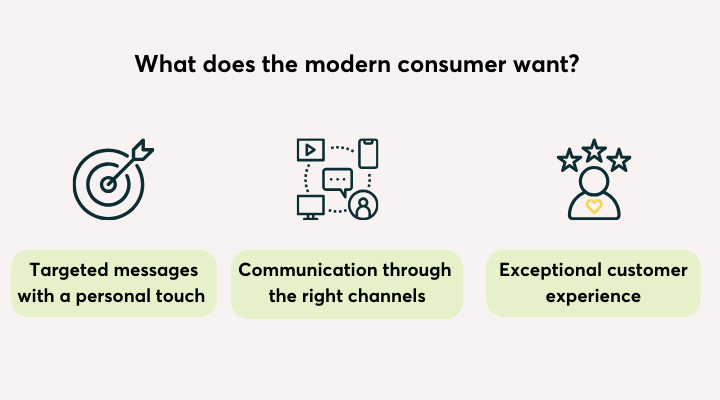Bulk messaging has been a crucial communication tool for businesses for many years, allowing them to reach numerous recipients quickly and cost-effectively. However, due to the evolution of technology and the changing needs of consumers, its effectiveness has begun to decline.
This article will discuss why bulk messaging no longer meets market needs. We will explore how businesses can use segmentation and personalization to increase conversions and build strong customer relationships.

Source: Readwhite.com
Demystifying Bulk Messaging
Bulk messaging, although once considered an innovative tool in corporate communication, now has many weaknesses that make it ineffective in today's market.
Reduced impact
Consumers are bombarded with hundreds of messages every day. Amidst this "noise", mass messages that do not address the needs of the recipients fail to gain their attention. The result is reduced reach and loss of interest on the part of consumers.
Risk of ending up in spam
Communications service providers (CSP) have developed and tightened their spam and junk mail filters. Bulk standardized messages are frequently flagged as spam and directed to the spam folder, whether email or messaging platform messages. This prevents recipients from reading the messages and also impacts the credibility and reputation of the business with the service providers.
Disturbing for the recipients
When recipients constantly receive mass and impersonal messages, they may feel annoyed. Particularly when they don't have the option to easily unsubscribe from your list to stop receiving your communications, the business faces the risk of reputational damage.
Poor customer experience
A poor customer experience often stems from bulk messaging, which overlooks the unique preferences and needs of individual customers, leading to a generic approach. This can make customers feel undervalued as individuals, consequently diminishing their satisfaction with the company.
Reduced efficiency
Non-targeted bulk campaigns show a 50% lower CTR than segmented campaigns. This happens as mass communications fail to convince recipients to take a desired action, such as a purchase or newsletter subscription, leading to a low return on investment (ROI).
Financial expense without the desired results
Sending mass messages is undoubtedly a financial investment and when the results are not as expected, businesses lose significant resources without achieving their goals.
What does the modern consumer want?

Modern consumers hold specific expectations and heightened demands from the businesses they interact with. A business's capacity to fulfill these expectations is a significant factor in the success of its communications and whether or not establishing a meaningful connection with the consumer.
Targeted communication
Consumers desire messages that cater to their individual needs and preferences. Such personalized communication fosters a perception that businesses recognize and appreciate each person's unique interests, thereby enhancing consumer trust and fostering loyalty.
Selecting the right channels
Each consumer has distinct preferences regarding the channels they wish to receive communications from their preferred brands. Whether it's SMS, Viber, or Email, selecting the right communication channels is vital for the success of your marketing strategy.
When subscribing to your lists, give users the option to choose from which channels they want to receive your communications
Exceptional consumer experience
Personalized communication enhances the overall customer experience and brand loyalty. Keep content relevant and engaging to boost further customer satisfaction.
Achieving this objective
Businesses aiming to stay ahead in the market need to embrace innovative marketing strategies that prioritize personalized and segmented communication to address consumer needs effectively.
Segmented Campaigns
Categorizing the audience into smaller segments based on specific characteristics and interests is the first and most essential step toward improving a company's communication with its audience. This approach allows businesses to create more targeted and effective campaigns.
Advantages of Segmented Campaigns
- Personalized messages: Messages that are tailored to meet the needs and interests of recipients are more likely to capture their attention and score higher open rates.
- Improved engagement: Segmented messages record a higher click-through rate (CTR). Consumers are more likely to open and engage with messages they find relevant and interesting.
- Increased conversions: Targeted campaigns lead to a higher conversion rate (CR) since recipients are more likely to respond positively to a personalized approach that meets their needs.
- Building strong relationships and enhanced customer retention: Personalized communication builds trust and enhances customer loyalty. When customers feel they are treated as unique individuals, they are more likely to remain loyal to the business.
- Cost-effective solution: Targeted campaigns, while requiring more effort, are ultimately more cost-effective and deliver better results. Businesses can reduce communication costs and increase the efficiency of their marketing efforts.
Segmenting audiences and crafting targeted, personalized messages are key to thriving in the current business communication landscape. Companies that implement these tactics can expect enhanced outcomes, heightened customer contentment, and superior performance.
Start today with Apifon to transition from bulk messaging to targeted campaigns, reducing advertising costs and boosting conversion rates

